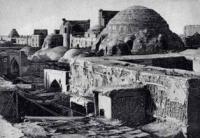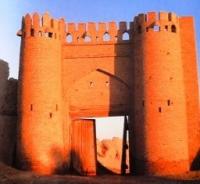You are here
The historical description of Bukhara.


Places of interest of Bukhara.
"They say the Arabs right, here I am with them at the same time:
At the time of spring flowering, it is not criminal to drink wine;
With a young peri from Hallluha, you would make friends now -
So that she, like a Chin idol, caresses her eyes with beauty,
To enter gait languid in our intoxicating, cheerful circle,
To draw on the glasses: “Are you a brave man, a desirable friend?”
Bade Balkhi, translated by D. Vinogradov.
Transfers to Bukhara.
Bukhara, which is situated on the Silk Route, is some 25 centuries old. It is the most complete example of a medieval city in Central Asia, with an urban fabric that has remained largely intact.
Monuments of particular interest include the famous tomb of Ismail Samani, a masterpiece of Xth-century Muslim architecture, and a large number of XVII century madrasah. The historic part of the city, which is in effect an open-air museum, combines the city's long history in a single ensemble.
Archaeological excavations have revealed that the settlement on the site of latter-day Bukhara became part of the Kushan state as early as the 2nd millennium BC. In the IV century it was incorporated into the Ephtalite state.
Before the Arab conquest Bukhara was one of the largest cities of Central Asia, owing its prosperity to its site on a rich oasis and at the crossroads of ancient trade routes. It became a major cultural centre of the Caliphate of Baghdad in 709, and in 892 the capital of the independent Samanid Kingdom.
A time of great economic growth came to an end with the sack of the city in 1220 by the Mongol horde of Genghis Khan. It slowly recovered, to become part of the Timurid Empire.
The internal strife of the late XV century led to the occupation of Bukhara by nomadic Uzbek tribesmen led by Khan Sheibani, becoming the capital of the Bukhara Khanate.
A long period of unrest and short-lived dynasties ended in 1920, when it was absorbed into the Soviet Union; nevertheless, this period saw Bukhara consolidating its role as a major commercial and cultural centre.
The townscape of latter-day Bukhara represents every stage of the city's history. The earliest monuments include the X century Ismail Samani Tomb, the decorated brick minaret of Poi-Kalyan from the XI century, along with the Magoki Mosque and the Chasma Ayub Shrine.
The Timurid period is represented only by the Ulugbek Medresseh. The most celebrated buildings date from the Shebibanid period - the Poi-Kalyan group, the Lyabi-Khauz ensemble, the Kosh Medresseh, and the Gaukushon Medresseh.
A little later came the medressehs at important crossroads, such as Taki Sarafon (Dome of the Moneyshangers, Taki-Tilpak-Furushan (Dome of the Headguard Sellers), Tim-Bazzazan, and Tim-Abdullah-Khan.
Among the fine buildings erected in the anarchic early XVII century must be included the great new mosque Magoki Kurns (1637) and the imposing Abdullah-Khan Madrasah. It should be stressed, however, that the real importance of Bukhara lies not in its individual buildings but rather in its overall level of urban planning and architecture, which began with the Sheibanid dynasty.
Archaeological excavations have revealed that the settlement on the site of latter-day Bukhara became part of the Kushan state as early as the 2nd millennium BC. In the IV century BC it was incorporated into the Ephtalite state.
Before the Arab conquest, Bukhara was one of the largest cities of central Asia, owing its prosperity to its site on a rich oasis and at the crossroads of ancient trade-routes. The ancient Persian city covered an area of nearly 40 hectares, with the ark (citadel), the residence of its rulers, in the north-west quarter (where it survives as a huge rectangular earthen mound).
It became a major cultural centre of the Caliphate of Baghdad in 709. In 892 Emir Ismail ibn Amad (892 - 907) created an independent state and chose Bukhara as the capital of the powerful Sarnanid kingdom.
There followed a period of great economic and cultural growth, when the city grew enormously in size, especially under the rule of the Karakhanids from the XI century onwards. In 1220 the city was sacked by the Mongol horde of Chinghiz Khan (1220) and was not to recover until the second half of the XIII century.
In 1370 it became part of the great Timurid Empire, whose capital was at Samarkand. Bukhara was still the second city of Maverannahr, and building was renewed. The late XV century saw much feudal strife in the declining Timurid lands, with the result that Bukhara was occupied by Uzbek nomadic tribesmen led by Khan Sheibani, under whose dynasty it became the centre of the Uzbek state.
The Bukhara khanate was assiduous in promoting economic and cultural development in its territory, and the city was the main beneficiary of the new construction that ensued. In the centuries that followed the death of Abdullah Khan in 1598 there was a succession of short-lived dynasties and from the late XVIII century the resulting weakness led to continual raids and pillage by neighbouring rulers.
It was not until 1753 that Bukhara became the capital of a new Mangut dynasty that was to survive until 1920. During this period the city was a major trade entrepot for the whole of central Asia (although it was incorporated into the Russian Empire in 1868).
In 1848 it had no fewer than 38 caravanserais, six trading arcades, 16 public baths, and 45 bazaars. Bukhara was also the largest centre for Muslim theology in the Near East, with over two hundred mosques and more than a hundred madrsssahs.
Authority:
Historical heritage of UNESCO







